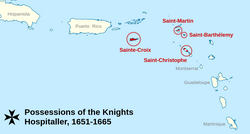
Back تاريخ مالطا تحت نظام فرسان القديس يوحنا Arabic Ιστορία της Μάλτας υπό το Τάγμα του Αγίου Ιωάννη Greek Historia de Malta bajo la Orden de San Juan Spanish Ordre de Saint-Jean de Jérusalem à Malte French Stato monastico dei Cavalieri di Malta Italian 구호기사단 치하의 몰타 Korean Historia Malty pod rządami joannitów Polish Malta Hospitaleira Portuguese Hospitalier Maltası Turkish 医院骑士团治下的马耳他 Chinese
Hospitaller Malta | |||||||||||||||||
|---|---|---|---|---|---|---|---|---|---|---|---|---|---|---|---|---|---|
| 1530–1798 | |||||||||||||||||
 Map of Malta and Gozo in relation to Sicily and Hospitaller Tripoli | |||||||||||||||||
 Map of the Order's territories in the Caribbean | |||||||||||||||||
| Status | Vassal state of the Kingdom of Sicily (1530–1753) Sovereignty proclaimed in 1753 | ||||||||||||||||
| Capital | Birgu (1530–1571) Valletta (1571–1798) | ||||||||||||||||
| Common languages | Italian, Latin (official) Maltese (unofficial) | ||||||||||||||||
| Religion | Roman Catholicism | ||||||||||||||||
| Demonym(s) | Maltese | ||||||||||||||||
| Government | Theocratic elective monarchy | ||||||||||||||||
| Grand Master | |||||||||||||||||
• 1530–1534 | Philippe Villiers de L'Isle-Adam (first) | ||||||||||||||||
• 1797–1798 | Ferdinand von Hompesch zu Bolheim (last) | ||||||||||||||||
| Historical era | Early modern period | ||||||||||||||||
| 24 March 1530 | |||||||||||||||||
• Established | 26 October 1530 | ||||||||||||||||
| 15 August 1551 | |||||||||||||||||
| 21 May 1651 | |||||||||||||||||
• Sale of Caribbean territories | 1665 | ||||||||||||||||
• Proclamation of sovereignty | 1753 | ||||||||||||||||
| 12 June 1798 | |||||||||||||||||
| Area | |||||||||||||||||
• Total | 316 km2 (122 sq mi) | ||||||||||||||||
| Population | |||||||||||||||||
• 1530 (estimate)[1] | 33,000 | ||||||||||||||||
• 1632 (census)[1] | 51,750 | ||||||||||||||||
• 1741 (estimate)[1] | 110,000 | ||||||||||||||||
| Currency | Maltese scudo[2]
Other currencies
| ||||||||||||||||
| ISO 3166 code | MT | ||||||||||||||||
| |||||||||||||||||
Area and population excluding Tripoli and the Caribbean islands | |||||||||||||||||
Hospitaller Malta, officially the Monastic State of the Order of Malta,[citation needed] and known within Maltese history as the Knights' Period (Maltese: Żmien il-Kavallieri,[3][4] "Time of the Knights"), was a polity which existed between 1530 and 1798 when the Mediterranean islands of Malta and Gozo were ruled by the Order of St. John of Jerusalem. It was formally a vassal state of the Kingdom of Sicily, and it came into being when Emperor Charles V granted the islands as well as the city of Tripoli in modern Libya to the Order, following the latter's loss of Rhodes in 1522. Hospitaller Tripoli was lost to the Ottoman Empire in 1551, but an Ottoman attempt to take Malta in 1565 failed.
Following the 1565 siege, the Order decided to settle permanently in Malta and began to construct a new capital city, Valletta. For the next two centuries, Malta went through a Golden Age, characterized by a flourishing of the arts, architecture, and an overall improvement in Maltese society.[5] In the mid-17th century, the Order was the de jure proprietor over some islands in the Caribbean,[6] making it the smallest state to colonize the Americas.[citation needed]
The Order began to decline in the 1770s, and was severely weakened by the French Revolution in 1792. In 1798, French forces under Napoleon invaded Malta and expelled the Order, resulting in the French occupation of Malta. The Maltese eventually rebelled against the French, and the islands became a British protectorate in 1800. Malta was to be returned to the Order by the Treaty of Amiens in 1802, but the British remained in control and the islands formally became a British colony by the Treaty of Paris in 1814.
- ^ a b c "History of the Census". National Statistics Office. Archived from the original on 16 June 2022.
- ^ "Coinage of the Knights in Malta". Central Bank of Malta. Archived from the original on 6 October 2014.
- ^ Ghirxi, Frans (1984). Żmien il-Kavallieri f'Malta.
- ^ Grima, Joseph F. (2001). Żmien il-Kavallieri f'Malta 1530–1798. PIN Publications. ISBN 99932-41-11-3.
- ^ "The culture of Malta throughout the millennia". malta.com. Archived from the original on 4 March 2016.
- ^ Mifsud, A. (1914). Knights Hospitallers of the Venerable Tongue of England in Malta. Valletta, Malta. p. 246. ISBN 0-404-17009-9.
© MMXXIII Rich X Search. We shall prevail. All rights reserved. Rich X Search

